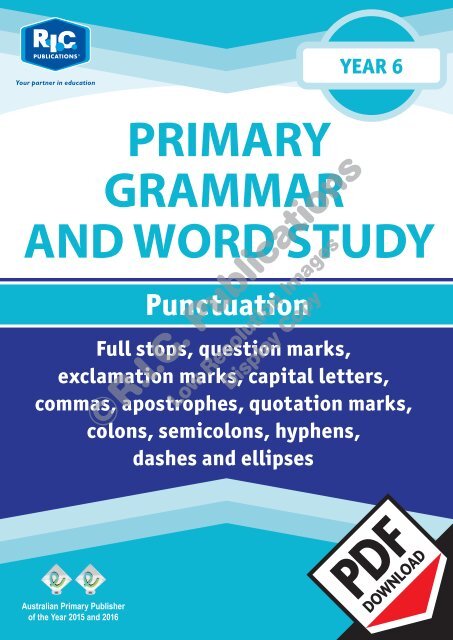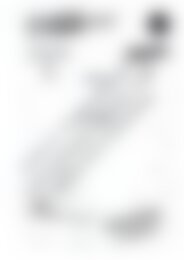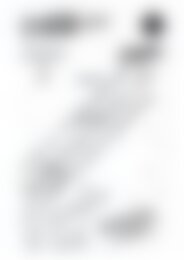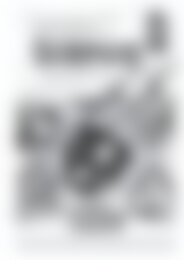RIC-20248 Primary Grammar and Word Study Year 6 – Punctuation
Create successful ePaper yourself
Turn your PDF publications into a flip-book with our unique Google optimized e-Paper software.
Your partner in education<br />
YEAR 6<br />
PRIMARY<br />
GRAMMAR<br />
YEAR 1<br />
AND WORD STUDY<br />
<strong>Punctuation</strong><br />
Full stops, question marks,<br />
exclamation marks, capital letters,<br />
commas, apostrophes, quotation marks,<br />
colons, semicolons, hyphens,<br />
dashes <strong>and</strong> ellipses<br />
©R.I.C. Publications<br />
Low Resolution Images<br />
Display Copy<br />
Australian <strong>Primary</strong> Publisher<br />
of the <strong>Year</strong> 2015 <strong>and</strong> 2016
<strong>Primary</strong> grammar <strong>and</strong> word study (Book G)<br />
Published by R.I.C. Publications ® 2008<br />
Copyright © by R.I.C. Publications ® 2008<br />
This master may only be reproduced by the<br />
original purchaser for use with their class(es). The<br />
publisher prohibits the loaning or onselling of this<br />
master for the purposes of reproduction.<br />
<strong>RIC</strong><strong>–</strong><strong>20248</strong><br />
Copyright Notice<br />
Blackline masters or copy masters are published <strong>and</strong><br />
sold with a limited copyright. This copyright allows<br />
publishers to provide teachers <strong>and</strong> schools with a<br />
wide range of learning activities without copyright<br />
being breached. This limited copyright allows the<br />
purchaser to make sufficient copies for use within<br />
their own education institution. The copyright is not<br />
transferable, nor can it be onsold. Following these<br />
instructions is not essential but will ensure that you,<br />
as the purchaser, have evidence of legal ownership<br />
to the copyright if inspection occurs.<br />
For your added protection in the case of copyright<br />
inspection, please complete the form below. Retain<br />
this form, the complete original document <strong>and</strong> the<br />
invoice or receipt as proof of purchase.<br />
Name of Purchaser:<br />
Date of Purchase:<br />
Supplier:<br />
School Order# (if applicable):<br />
Signature of Purchaser:<br />
©R.I.C. Publications<br />
Low Resolution Images<br />
Display Copy<br />
Internet websites<br />
In some cases, websites or specific URLs may be recommended. While these are checked <strong>and</strong> rechecked at the time of publication,<br />
the publisher has no control over any subsequent changes which may be made to webpages. It is strongly recommended that the class<br />
teacher checks all URLs before allowing students to access them.<br />
View all pages online<br />
PO Box 332 Greenwood Western Australia 6924<br />
Website: www.ricpublications.com.au<br />
Email: mail@ricgroup.com.au
<strong>Primary</strong> grammar <strong>and</strong><br />
word study <strong>–</strong> Book G<br />
Foreword<br />
<strong>Primary</strong> grammar <strong>and</strong> word study is a series of seven books designed<br />
to introduce students to parts of speech, ways to underst<strong>and</strong> <strong>and</strong> choose<br />
words, punctuation <strong>and</strong> figures of speech.<br />
Titles in this series:<br />
• <strong>Primary</strong> grammar <strong>and</strong> word study Book A (Ages 5<strong>–</strong>6)<br />
• <strong>Primary</strong> grammar <strong>and</strong> word study Book B (Ages 6<strong>–</strong>7)<br />
• <strong>Primary</strong> grammar <strong>and</strong> word study Book C (Ages 7<strong>–</strong>8)<br />
• <strong>Primary</strong> grammar <strong>and</strong> word study Book D (Ages 8<strong>–</strong>9)<br />
• <strong>Primary</strong> grammar <strong>and</strong> word study Book E (Ages 9 <strong>–</strong>10)<br />
• <strong>Primary</strong> grammar <strong>and</strong> word study Book F (Ages 10<strong>–</strong>11)<br />
• <strong>Primary</strong> grammar <strong>and</strong> word study Book G (Ages 11<strong>–</strong>12)<br />
Teachers notes .............................................. iv <strong>–</strong> v<br />
Curriculum links ................................................... v<br />
Literacy character explanation ...................... vi <strong>–</strong> vii<br />
Checklists.................................................... viii <strong>–</strong> xi<br />
Parts of speech .............................................. 2<strong>–</strong>33<br />
Nouns .............................................................. 2<strong>–</strong>5<br />
Verbs .............................................................. 6<strong>–</strong>11<br />
Adjectives..................................................... 12<strong>–</strong>17<br />
Adverbs ........................................................ 18<strong>–</strong>21<br />
Pronouns ...................................................... 22<strong>–</strong>25<br />
Conjunctions ................................................ 26<strong>–</strong>27<br />
Determiners ................................................. 28<strong>–</strong>31<br />
Prepositions ................................................ 32<strong>–</strong>33<br />
Underst<strong>and</strong>ing<br />
<strong>and</strong> choosing words..................................... 34<strong>–</strong>57<br />
<strong>Word</strong>s that are similar ...............................34<strong>–</strong>41<br />
Homographs ......................................... 34<strong>–</strong>35<br />
Homophones ........................................ 36<strong>–</strong>37<br />
Eponyms .............................................. 38<strong>–</strong>39<br />
Euphemisms ........................................ 40<strong>–</strong>41<br />
Contents<br />
<strong>Word</strong>s that change .....................................42<strong>–</strong>49<br />
Plurals .................................................. 42<strong>–</strong>45<br />
Prefixes ................................................ 46<strong>–</strong>47<br />
Suffixes ................................................ 48<strong>–</strong>49<br />
<strong>Word</strong>s <strong>and</strong> their meanings ........................50<strong>–</strong>53<br />
Synonyms <strong>and</strong> antonyms...................... 50<strong>–</strong>51<br />
<strong>Word</strong> origins ......................................... 52<strong>–</strong>53<br />
Confused words .........................................54<strong>–</strong>57<br />
©R.I.C. Publications<br />
Low Resolution Images<br />
Display Copy<br />
<strong>Punctuation</strong> .................................................. 58<strong>–</strong>75<br />
Full stops, question marks,<br />
exclamation marks <strong>and</strong> capital letters .......... 58<strong>–</strong>59<br />
Commas ....................................................... 60<strong>–</strong>63<br />
Apostrophes ................................................. 64<strong>–</strong>67<br />
Quotation marks ........................................... 68<strong>–</strong>71<br />
Colons <strong>and</strong> semicolons ................................. 72<strong>–</strong>73<br />
Hyphens, dashes <strong>and</strong> ellipses ....................... 74<strong>–</strong>75<br />
Figures of speech ......................................... 76<strong>–</strong>85<br />
Colloquialisms <strong>and</strong> jargon ............................. 76<strong>–</strong>77<br />
Hyperbole ..................................................... 78<strong>–</strong>79<br />
Idioms .......................................................... 80<strong>–</strong>81<br />
Metaphors <strong>and</strong> similes ................................. 82<strong>–</strong>83<br />
Proverbs ....................................................... 84<strong>–</strong>85<br />
R.I.C. Publications ® www.ricpublications.com.au iii<br />
<strong>Primary</strong> grammar <strong>and</strong> word study
<strong>Punctuation</strong> checklist<br />
Name of student<br />
Full stops<br />
Question<br />
marks<br />
Exclamation<br />
marks<br />
Capital<br />
letters<br />
Commas Apostrophes Quotation<br />
marks<br />
Colons/<br />
Semicolons<br />
Hyphens/<br />
Dashes/<br />
Ellipses<br />
©R.I.C. Publications<br />
Low Resolution Images<br />
Display Copy<br />
<strong>Primary</strong> grammar <strong>and</strong> word study x<br />
www.ricpublications.com.au R.I.C. Publications ®
<strong>Punctuation</strong><br />
<strong>Punctuation</strong> marks <strong>and</strong> capital letters<br />
Focus<br />
Capital letters for sentence beginnings <strong>and</strong> proper nouns<br />
Full stops at the end of a sentence <strong>and</strong> for abbreviations<br />
Question marks<br />
Exclamation marks<br />
Definitions<br />
• Full stops are punctuation marks used to show the end<br />
of a sentence.<br />
• An abbreviation is a shortened form of a word.<br />
A full stop can be used to show that a word has been<br />
abbreviated.<br />
Example:<br />
telephone — tel. or continued — cont.<br />
• Question marks are punctuation marks used to indicate<br />
a question.<br />
• Exclamation marks are punctuation marks used at the<br />
end of a remark to show strong emotion or feeling.<br />
Example:<br />
Oh no! I left it on the kitchen table!<br />
Explanation<br />
• Full stops, also called periods, usually show the end of<br />
an idea or thought in a sentence. They can also indicate<br />
that a break is needed when reading.<br />
• In abbreviations, full stops are not used when the last<br />
letter is the last letter of the word.*<br />
Example:<br />
Rd, St, Dr<br />
• The necessity for faster communication has contributed<br />
to some changes.<br />
• Abbreviations of proper nouns, such as New South<br />
Wales (NSW) no longer need full stops. They are now<br />
only used to avoid confusion.<br />
Example:<br />
R.I.C. Publications ®<br />
The full stops are used to indicate pronunciation.<br />
• A question is an interrogative statement, addressed to<br />
someone in order to elicit information.<br />
• Exclamation marks usually indicate strong feeling, such<br />
as surprise, disgust or anger. An exclamation mark<br />
can be used at the end of an interjection (Oh no!) or<br />
comm<strong>and</strong> (Don’t touch!) <strong>and</strong> to add emphasis.<br />
Worksheet information<br />
• Revise the information about full stops, question marks,<br />
exclamation marks, abbreviations <strong>and</strong> capital letters,<br />
giving some examples before allowing the students to<br />
complete the worksheet.<br />
• NOTE: The text on page 59 has been written to utilise<br />
specific words <strong>and</strong> is in no way intended to tell students<br />
the correct way to write assignments.<br />
Ideas for further practice<br />
• Revise incorrectly-identified errors in future grammar<br />
lessons.<br />
• Provide students with opportunities to edit punctuation<br />
in other texts, including the work of other students.<br />
Answers<br />
1. Mr Bannerman, our class teacher, is helping us get<br />
ready for Gillespie Secondary School next year.<br />
From September, until the time that we graduate in<br />
December, he is helping us to complete assignments<br />
in the same way that our secondary teachers will<br />
expect. It sounded really hard to me at first! How<br />
much work would we have to do?<br />
First, we needed to be able to write a well-constructed<br />
paragraph with an introductory sentence <strong>and</strong><br />
supporting information. That wasn’t too hard! It was<br />
just like writing a different type of story. Who couldn’t<br />
follow a set of guidelines to do that? I could!<br />
Next, we needed to be able to refer to a chapter in a<br />
particular book. We also needed to be able to include<br />
diagrams <strong>and</strong> a figure if the text needs them. Both of<br />
those were easy! Finally, we needed to be able to add<br />
an appendix if necessary. There are so many things to<br />
do! Will we be able to remember them all? I hope so!<br />
©R.I.C. Publications<br />
Low Resolution Images<br />
Display Copy<br />
2. Refer to<br />
wordsearch<br />
solution<br />
R F C O N T I N U E D V Y B<br />
I B B C X D N A L S I I K F<br />
V G A A S S O C I A T I O N<br />
E P I N C O R P O R A T E D<br />
R P R O F E S S O R W M S E<br />
Y N A P M O C R Y A D I R F<br />
J H T A I L A R T S U A T X<br />
Y L B A B O R P A U S U A L<br />
G O V E R N O R G L E G A P<br />
A P R I L J S S C H O O L S<br />
H T T E L E P H O N E J W J<br />
* R.I.C. Publications employs full stops for abbreviations<br />
as recommended by the Style manual for authors,<br />
editors <strong>and</strong> printers, sixth edition, 2002.<br />
<strong>Primary</strong> grammar <strong>and</strong> word study 58<br />
www.ricpublications.com.au R.I.C. Publications ®
<strong>Punctuation</strong> marks <strong>and</strong><br />
capital letters<br />
1. Edit the text below to include full stops, capital letters for sentence beginnings, capital letters for proper<br />
nouns, exclamation marks <strong>and</strong> question marks.<br />
Write your corrections above each error.<br />
mr bannerman, our class teacher, is helping us get ready for gillespie secondary<br />
school next year from september, until the time that we graduate in december, he is<br />
helping us to complete assignments in the same way that our secondary teachers<br />
will expect it sounded really hard to me at first how much work would we have to do<br />
first, we needed to be able to write a well-constructed paragraph with an<br />
introductory sentence <strong>and</strong> supporting information that wasn’t too hard it was just<br />
like writing a different type of story who couldn’t follow a set of guidelines to do that<br />
i could<br />
next, we needed to be able to refer to a chapter in a particular book we also needed<br />
to be able to include diagrams <strong>and</strong> a figure if the text needs them both of those were<br />
easy finally, we needed to be able to add an appendix if necessary there are so many<br />
things to do will we be able to remember them all i hope so<br />
2. Find complete words in the word search using the abbreviation clues.<br />
©R.I.C. Publications<br />
Low Resolution Images<br />
Display Copy<br />
<strong>Word</strong>s such as ‘September’, ‘paragraph’, ‘chapter’, <strong>and</strong> ‘appendix’ can be abbreviated to ‘Sept.’, ‘para.’,<br />
‘chap.’ <strong>and</strong> ‘app.’ using full stops.<br />
(a) tel. (b) cont.<br />
(c) Co. (d) Is.<br />
(e) Inc. (f) p.<br />
(g) Apr. (h) sch.<br />
(i) Aust. (j) assoc.<br />
(k) Gov. (l) prob.<br />
(m) riv. (n) Prof.<br />
(o) usu. (p) Fri.<br />
R F C O N T I N U E D V Y B<br />
I B B C X D N A L S I I K F<br />
V G A A S S O C I A T I O N<br />
E P I N C O R P O R A T E D<br />
R P R O F E S S O R W M S E<br />
Y N A P M O C R Y A D I R F<br />
J H T A I L A R T S U A T X<br />
K Y L B A B O R P U S U A L<br />
G O V E R N O R G L E G A P<br />
A P R I L J S S C H O O L S<br />
H T T E L E P H O N E J W J<br />
R.I.C. Publications ® www.ricpublications.com.au 59<br />
<strong>Primary</strong> grammar <strong>and</strong> word study
<strong>Punctuation</strong><br />
Commas<br />
Focus<br />
Commas in a series of words, clauses <strong>and</strong> phrases<br />
Commas in the middle of a sentence to set off a phrase<br />
or clause<br />
Definitions<br />
• Commas are punctuation marks used to separate<br />
words, phrases or clauses to clarify meaning.<br />
• A phrase is a group of words in a sentence which<br />
does not have a finite verb (i.e. a verb with a<br />
subject).<br />
• A clause is a group of words, including a verb <strong>and</strong><br />
its subject. (A clause can be a simple sentence.)<br />
Explanation<br />
• In a series, the comma st<strong>and</strong>s for an omitted<br />
conjunction, such as ‘<strong>and</strong>’ or ‘or’.<br />
Example:<br />
‘I play the violin, cello <strong>and</strong> piano’ means ‘I play<br />
the violin <strong>and</strong> cello <strong>and</strong> piano’. The comma has<br />
replaced the omitted ‘<strong>and</strong>’.<br />
• Commas can be used for:<br />
<strong>–</strong> a series of nouns.<br />
Example:<br />
The meal consisted of steak, peas <strong>and</strong> potatoes.<br />
<strong>–</strong> a series of verbs.<br />
Example:<br />
Jason ran, tripped, fell <strong>and</strong> fainted.<br />
<strong>–</strong> a series of adjectives.<br />
Example:<br />
She was young, beautiful, kind <strong>and</strong> naive.<br />
<strong>–</strong> a series of phrases.<br />
Example:<br />
He doesn’t like washing dishes, ironing clothes or<br />
mopping floors.<br />
• A pair of commas can be used in the middle of a<br />
sentence to set off a phrase or clause which is not<br />
essential to the meaning of the sentence. The first<br />
comma indicates the beginning of the phrase or<br />
clause <strong>and</strong> the second indicates the end of that<br />
phrase or clause.<br />
Example:<br />
That girl, wearing blue pyjamas, is my sister.<br />
Worksheet information<br />
• Read the text with the class. Students identify the<br />
sentences with lists of words, <strong>and</strong> the sentence<br />
with the lists of phrases or clauses. Explain that a<br />
phrase is a group of words which can form a unit in<br />
a sentence. It does not contain a subject ‘doing’ a<br />
verb. A clause does have a verb with a subject.<br />
• Read about using commas with clauses or phrases<br />
which provide additional information within the text.<br />
Provide some basic examples of phrases or clauses<br />
for the students or ask students to share their own<br />
ideas.<br />
• Students complete Questions 2, 3 <strong>and</strong> 4.<br />
Ideas for further practice<br />
• Finish the sentence. ‘Four animals which live in the<br />
Arctic are …’; ‘To make a pizza, we need …’ Create<br />
your own sentence starters.<br />
• Find a suitable newspaper article, copy it <strong>and</strong><br />
distribute to the class. Students identify sentences<br />
which contain lists of words, clauses <strong>and</strong> phrases<br />
<strong>and</strong> highlight them.<br />
• Students work in pairs. One student writes the<br />
sentence (missing the phrase or clause) while at the<br />
same time the other student (without looking at the<br />
first student’s sentence) writes a phrase or clause.<br />
The two are put together to create a silly sentence.<br />
©R.I.C. Publications<br />
Low Resolution Images<br />
Display Copy<br />
Answers<br />
1. Teacher check<br />
2. (a) a tropical fruit<br />
(b) providing Mum agrees<br />
3. (a) That man, loitering near the ATM, looks very<br />
suspicious. I think I’ll avoid using the machine<br />
for my banking today.<br />
(b) My favourite movie, which also happens to be<br />
a classic book, is ‘The lion, the witch <strong>and</strong> the<br />
wardrobe’.<br />
4. Teacher check<br />
<strong>Primary</strong> grammar <strong>and</strong> word study 60<br />
www.ricpublications.com.au R.I.C. Publications ®
Commas<br />
Commas are used to separate a series of words, phrases or clauses in a sentence to<br />
make the meaning clear.<br />
1. (a) Read the text.<br />
It was time to start planning our next family holiday. We sat down for our family meeting to<br />
decide where we would go, how we would get there, what we would like to do once we were<br />
there <strong>and</strong> how we would get the money together. I always loved these meetings. I really enjoyed<br />
the negotiating, planning, organising <strong>and</strong> debating. Mum, Dad, Marty, Susan <strong>and</strong> I always took<br />
some time to agree on a holiday destination. In order to keep everyone happy, we usually made a<br />
list of what each of us would like to do, we searched the Internet to find a location which would<br />
accommodate most activities <strong>and</strong> we finally agreed on the venue. We then each took a task to<br />
help in the organisation <strong>and</strong> planning of our holiday. I had to research the accommodation, Dad<br />
had to research our travel arrangements, Mum had to find out about transport, Marty had to<br />
calculate how much the activities were going to cost <strong>and</strong> Susan was responsible for making a<br />
suggested itinerary. We had to complete our tasks <strong>and</strong> report back one week later.<br />
(b) Circle all the commas used in lists of words, phrases <strong>and</strong> clauses.<br />
(c) Use a coloured pencil to underline words, phrases <strong>and</strong> clauses used in lists.<br />
Commas are used to identify a phrase or clause in a sentence which provides the reader with extra<br />
background information. If this extra information is taken out, the sentence will still make sense.<br />
©R.I.C. Publications<br />
Low Resolution Images<br />
Display Copy<br />
2. Underline the phrase or clause which gives extra information in each of these sentences.<br />
(a) Pawpaw, a tropical fruit, is considered very valuable because of its healing properties.<br />
(b) I’m hoping, providing Mum agrees, to invite four friends over for a slumber party for my birthday.<br />
3. Use commas to identify the phrase or clause providing extra information in each of these sentences.<br />
(a) That man loitering near the ATM looks very suspicious. I think I’ll avoid using the machine for my banking<br />
today.<br />
(b) My favourite movie which also happens to be a classic book is ‘The lion, the witch <strong>and</strong> the wardrobe’.<br />
4. Write a phrase or clause to complete each sentence <strong>and</strong> add any necessary commas.<br />
(a) The firefighters<br />
enormous flames coming from the factory.<br />
(b) The green sea turtle<br />
of body fat which is green from the algae it eats.<br />
as they worked feverishly to battle the<br />
is so named because of the layer<br />
R.I.C. Publications ® www.ricpublications.com.au 61<br />
<strong>Primary</strong> grammar <strong>and</strong> word study
<strong>Punctuation</strong><br />
Commas<br />
Focus<br />
Commas used to join two or more simple sentences<br />
Definition<br />
• Commas are punctuation marks used to separate<br />
words or phrases to clarify meaning.<br />
Explanation<br />
• Commas can be used with a conjunction to join<br />
two simple sentences into a longer, more complex<br />
sentence.<br />
• The most common sentence type is the simple<br />
sentence. Too many simple sentences in writing can<br />
make the writing seem childish. Joining two or more<br />
simple sentences to make a complex or compound<br />
sentence can add a sense of maturity <strong>and</strong> interest to<br />
the text.<br />
Worksheet information<br />
• Read the information <strong>and</strong> examples provided. Ask<br />
students to offer simple sentences of their own. Use<br />
these to demonstrate <strong>and</strong> practise joining two or<br />
more simple sentences together.<br />
• Students identify the simple sentences within each<br />
sentence.<br />
• Students then practise joining simple sentences.<br />
Ideas for further practice<br />
• Find a suitable newspaper article, copy it <strong>and</strong><br />
distribute to the class. Students identify simple<br />
sentences <strong>and</strong> practise joining them. Identify more<br />
complex sentences with a comma used to combine<br />
two or more simple sentences.<br />
• Students work in pairs. One student writes one<br />
simple sentence while at the same time the other<br />
student (without looking at the first student’s<br />
sentence) writes another simple sentence. The two<br />
are put together to create a silly sentence.<br />
Answers<br />
1. (a) I mowed the lawn, so Jayden trimmed the<br />
edges.<br />
(b) The sun melted the snow, then in one hour it<br />
had totally disappeared.<br />
(c) Mum went shopping on Saturday, while Dad<br />
took us to the movies.<br />
(d) Bradley went swimming at the beach, but I<br />
built enormous s<strong>and</strong>castles.<br />
(e) Dad wouldn’t let me go to the party, so I threw<br />
a huge tantrum.<br />
2. Teacher check. Possible answers include:<br />
(a) Barry likes to eat fried rice, so he eats it at<br />
least once a week.<br />
(b) Our cat is getting very old, so we pay special<br />
attention to her.<br />
(c) It is important to eat a balanced diet, so Mum<br />
makes sure we eat the right amount from<br />
each food group each day.<br />
(d) Although natural honey is great on toast for<br />
breakfast, it is also known for its fantastic<br />
healing properties on wounds <strong>and</strong> ulcers.<br />
©R.I.C. Publications<br />
Low Resolution Images<br />
Display Copy<br />
(e) We all know that it is important to exercise for<br />
at least 30 minutes each day, yet so many of<br />
us are lucky if we do 30 minutes of exercise in<br />
one week.<br />
<strong>Primary</strong> grammar <strong>and</strong> word study 62<br />
www.ricpublications.com.au R.I.C. Publications ®
Commas joining simple sentences<br />
A comma, together with a conjunction, can be used to join together two or more<br />
simple sentences to make your writing more interesting.<br />
For example: My friend invited me to a party. I do not want to go.<br />
My friend invited me to a party but I do not want to go.<br />
Although my friend invited me to a party, I do not want to go.<br />
1. Underline each simple sentence.<br />
(a) I mowed the lawn, so Jayden trimmed the edges.<br />
(b) The sun melted the snow, then in one hour it had totally disappeared.<br />
(c) Mum went shopping on Saturday, while Dad took us to the movies.<br />
(d) Bradley went swimming at the beach, but I built enormous s<strong>and</strong>castles.<br />
(e) Dad wouldn’t let me go to the party, so I threw a huge tantrum.<br />
2. Use a comma together with a conjunction (although, yet, so, but, or) to join two sentences.<br />
(a) Barry likes to eat fried rice. He eats it at least once a week.<br />
(b) Our cat is getting very old. We pay special attention to it.<br />
(c) It is important to eat a balanced diet. Mum makes sure we eat the right amount from each food group each<br />
day.<br />
©R.I.C. Publications<br />
Low Resolution Images<br />
Display Copy<br />
(d) Natural honey is great on toast for breakfast. It is also known for its fantastic healing properties on wounds<br />
<strong>and</strong> ulcers.<br />
(e) We all know that it is important to exercise for at least 30 minutes each day. So many of us are lucky if we<br />
do 30 minutes of exercise in one week.<br />
R.I.C. Publications ® www.ricpublications.com.au 63<br />
<strong>Primary</strong> grammar <strong>and</strong> word study
<strong>Punctuation</strong><br />
Apostrophes<br />
Focus<br />
Apostrophes in contractions<br />
Definition<br />
• A contraction is a shorter word made by joining two<br />
or more words <strong>and</strong> taking out one or more letters.<br />
The missing letter or letters is/are replaced by an<br />
apostrophe.<br />
Explanation<br />
• When two or more words are joined <strong>and</strong> contracted,<br />
the omitted letters are marked with an apostrophe.<br />
• The mistake is often made of placing the apostrophe<br />
between the two words, e.g. should’nt, do’nt.<br />
Students will need to be reminded that the<br />
apostrophe marks the missing letter <strong>and</strong> not the<br />
space where the two words join.<br />
• Contractions are commonly used in speech <strong>and</strong><br />
informal writing, but not often in formal writing.<br />
• Not all words with apostrophes are contractions.<br />
Apostrophes can also indicate possession.<br />
• Double contractions are common in speech; e.g.<br />
‘shouldn’t’ve’ <strong>and</strong> ‘who’d’ve’. It is important for<br />
students to be aware of the correct spelling of such<br />
words; e.g ‘I’d’ve’ is sometimes pronounced ‘I’da’.<br />
Worksheet information<br />
• Read <strong>and</strong> discuss the information in the introduction<br />
on the student page. After reading the pirate story,<br />
ask students to suggest the meanings of the unusual<br />
contractions, but do not provide them with the<br />
definitions as they will need to work them out in<br />
Question 1(b).<br />
• Students complete Question 1(b) by drawing a line<br />
from each contraction to its definition <strong>and</strong> the words<br />
that form the contraction. Advise students to read<br />
the text again to help them define each contraction.<br />
• For Question 2, students read the sentences<br />
<strong>and</strong> determine which word makes the ‘s’ in the<br />
contracted word. To find the correct answer,<br />
students may need to try saying each word (is, has<br />
<strong>and</strong> us) after the first half of the contraction.<br />
• In Question 3, students say the contracted word then<br />
write the words it is made from.<br />
Ideas for further practice<br />
• There are a number of online interactive games<br />
where students can practise contracting words. Try<br />
, <br />
Answers<br />
1. (a) man-o’-war, fo’c’sle, Cap’n, ne’er-do-well,<br />
Cap’n, will-o’-the-wisp, cat-o’-nine-tails<br />
Note: the apostrophes in ‘mother’s’ (showing<br />
possession) <strong>and</strong> ‘I’ll’ have not been included.<br />
(b) front part of ship <strong>–</strong> fo’c’sle <strong>–</strong> forecastle<br />
a whip with nine ‘tails’ <strong>–</strong> cat-o’-nine tails <strong>–</strong> cat<br />
of nine tails<br />
ghostly, flickering lights <strong>–</strong> will-o’-the-wisp <strong>–</strong><br />
will of the wisp<br />
a sailing ship with cannons <strong>–</strong> man-o’-war <strong>–</strong><br />
man of war<br />
an irresponsible or lazy person <strong>–</strong> ne’er-do-well<br />
<strong>–</strong> never do well<br />
according to the clock <strong>–</strong> o’clock <strong>–</strong> of the clock<br />
2. (a) us (b) is<br />
(c) has<br />
(d) has<br />
3. (a) They will have (b) could not have<br />
(c) should not have (d) Who would have<br />
©R.I.C. Publications<br />
Low Resolution Images<br />
Display Copy<br />
<strong>Primary</strong> grammar <strong>and</strong> word study 64<br />
www.ricpublications.com.au R.I.C. Publications ®
Apostrophes in contractions<br />
Contractions are words made by joining two or more words <strong>and</strong> taking out some<br />
letters. The letters are replaced by an apostrophe.<br />
Contractions are often used in speech because they are quicker <strong>and</strong> easier to say.<br />
They are not often used in writing, <strong>and</strong> hardly ever in ‘formal’ writing.<br />
1. (a) Some contractions used often in the past are not as common today. Read the text <strong>and</strong> underline the ‘old’<br />
contractions.<br />
The pirate captain guided the man-o’-war close to the coast. He stood on the fo’c’sle <strong>and</strong> peered<br />
through his telescope to the l<strong>and</strong> ahead.<br />
Cap’n! Look! Lights!<br />
‘Where?’ snarled the captain, his patience growing thin. ‘If this be one of your tricks again, you<br />
scrawny little ne’er-do-well ...’<br />
‘Cap’n, I swear on my own mother’s life I saw lights! Maybe ... do you think ... could it be ... will-o’-<br />
the-wisp?’<br />
‘Rubbish’, growled the captain. ‘You stop that superstitious nonsense or I’ll take to you with the cato’-nine-tails!’<br />
(b) Draw lines to match each contraction to its meaning <strong>and</strong> the words that were shortened to make it.<br />
front part of a ship • ne’er-do-well • man of war<br />
a whip with nine ‘tails’ • o’clock • cat of nine tails<br />
ghostly, flickering lights • fo’c’sle • of the clock<br />
a sailing ship with cannons • cat-o’-nine-tails • forecastle<br />
an irresponsible or lazy person • will-o’-the-wisp • never do well<br />
according to the clock • man-o’-war • will of the wisp<br />
2. Are these contractions ending in ‘s’ contractions of ‘is’, ‘has’, or ‘us’? Colour the correct boxes.<br />
(a) C’mon everyone! Let’s go!<br />
(b) She’s a great athlete, isn’t she?<br />
(c) Liam’s got an awesome new phone.<br />
(d) It’s been ages since I read that book.<br />
3. Some words have ‘double contractions’—for example, should’nt’ve (should not have)—which are spoken<br />
but rarely written. Read the sentences <strong>and</strong> write which words make up the contractions.<br />
(a) They’ll’ve eaten all the food by the time we get there!<br />
(b) It couldn’t’ve been me! I wasn’t even there!<br />
(c) I shouldn’t’ve eaten that pie!<br />
(d) Who’d’ve thought our Tim could have won a race!<br />
©R.I.C. Publications<br />
Low Resolution Images<br />
Display Copy<br />
us has is<br />
us has is<br />
us has is<br />
us has is<br />
R.I.C. Publications ® www.ricpublications.com.au 65<br />
<strong>Primary</strong> grammar <strong>and</strong> word study
<strong>Punctuation</strong><br />
Apostrophes<br />
Focus<br />
Common mistakes made when using apostrophes to<br />
show possession<br />
Definition<br />
• An apostrophe of possession indicates ownership<br />
<strong>and</strong> is placed directly after the owner/owners.<br />
Example:<br />
The girl’s uniform was saturated (one girl).<br />
The girls’ teacher was quite strict (more than one<br />
girl).<br />
The children’s school was close by.<br />
Explanation<br />
• Many people make the mistake of adding<br />
an apostrophe to make a noun plural. Such<br />
incorrect use of apostrophes is sometimes called<br />
‘greengrocers’ apostrophes’ (as the mistake can<br />
often be found on h<strong>and</strong>written signs, such as those<br />
found at the greengrocer).<br />
Worksheet information<br />
• Read the introductory text <strong>and</strong> common problems in<br />
the text boxes with the students. Discuss different<br />
ways to avoid making these mistakes. Some ideas<br />
include:<br />
<strong>–</strong> To work out where the apostrophe needs to go,<br />
students can circle the owner, add an apostrophe<br />
outside the right side of the circle, <strong>and</strong> add an ‘s’ if<br />
there isn’t one already there.<br />
<strong>–</strong> The possessive can often be identified by the<br />
presence of two nouns together. Students can<br />
check the first to see if it is possessive by<br />
substituting a possessive pronoun for it:<br />
Example:<br />
Carla’s shoes (her shoes).<br />
• Students then complete Questions 2 <strong>and</strong> 3,<br />
practising the correct use of the apostrophes to<br />
show ownership.<br />
Ideas for further practice<br />
• Students can practise using apostrophes correctly by<br />
doing one of the quizzes at <br />
• Encourage students to look for mistakes in<br />
newspaper articles, shop signs <strong>and</strong> ‘junk mail’. Bring<br />
these in <strong>and</strong> discuss how they are wrong <strong>and</strong> how<br />
the incorrect use of an apostrophe can change the<br />
meaning of the sentence.<br />
Answers<br />
1. Blake’s, hour’s, Mars’, planet’s, Igilpilly’s, Blake’s,<br />
stepbrothers’, Lee’s<br />
2. (a) Blake’s mum took so many photos, the<br />
memory card was full in five minutes.<br />
(b) Blake’s family enjoyed the one week’s journey<br />
to Mars’ spaceport in the 2030s.<br />
(c) Blake <strong>and</strong> his stepbrothers watched<br />
hundreds of DVDs on their way to Mars.<br />
(d) Blake had to carry all the suitcases, even<br />
Logan <strong>and</strong> Lee’s bags.<br />
3. (a) Maria <strong>and</strong> her brother’s new kittens were<br />
making a huge mess in Nanna’s house.<br />
(b) Kyle’s photos of his family’s holiday were<br />
great, especially the children’s s<strong>and</strong>castles.<br />
(c) The twin girls’ paintings were admired by<br />
hundreds of the art show’s visitors.<br />
©R.I.C. Publications<br />
Low Resolution Images<br />
Display Copy<br />
<strong>Primary</strong> grammar <strong>and</strong> word study 66<br />
www.ricpublications.com.au R.I.C. Publications ®
Apostrophes for possession<br />
When using an apostrophe to show ownership, the apostrophe goes straight after the<br />
owner or owners. Most apostrophes are shaped with a tail that points to the owner.<br />
For example: Cody’s dog’s ears went flat when Cody mentioned it was bathtime.<br />
The Bruce children had many pets. The children’s pets’ names all<br />
started with B.<br />
Using apostrophes correctly can be a bit tricky. Remember that they<br />
are used to show possession or a contraction, not plurals.<br />
For example: Oranges: Three dollars per kilo. (not three dollar’s)<br />
Those are my favourite CDs. (not CD’s)<br />
1. Read the text <strong>and</strong> circle the apostrophes that show possession.<br />
Public space travel had begun in the 2030s, <strong>and</strong> finally it was Blake’s turn. In an hour’s<br />
time he would be l<strong>and</strong>ing on Mars’ red surface. He looked out the window, keen to be<br />
the first to spot the planet’s spaceport. His little stepbrother, who of course had the best<br />
seat, beat him to it.<br />
‘Look, Mum!’ cried Logan. ‘There are the lights of Igilpilly’s port!’<br />
‘You mean Elegelly’, snorted Lee, the older of Blake’s two stepbrothers. Blake had almost<br />
had enough of his two stepbrothers’ bickering. The craft l<strong>and</strong>ed safely <strong>and</strong>, struggling<br />
with Logan <strong>and</strong> Lee’s bags, Blake stepped onto Mars, wishing he had a new family to go<br />
with his new life!<br />
2. Circle the mistakes then rewrite these sentences correctly.<br />
(a) Blakes mum took so many photo’s, the memory card was full in five minute’s.<br />
©R.I.C. Publications<br />
Low Resolution Images<br />
Display Copy<br />
(b) Blakes family enjoyed the one weeks journey to Mar’s spaceport in the 2030’s.<br />
(c) Blake <strong>and</strong> his stepbrother’s watched hundreds of DVD’s on their way to Mars’.<br />
(d) Blake had to carry all the suitcase’s, even Logan <strong>and</strong> Lees’ bag’s.<br />
3. Put apostrophes in the correct place in these sentences.<br />
(a) Maria <strong>and</strong> her brothers new kittens were both making a huge mess in Nannas house.<br />
(b) Kyles photos of his familys holiday were great, especially the childrens s<strong>and</strong>castles.<br />
(c) The twin girls paintings were admired by hundreds of the art shows visitors.<br />
R.I.C. Publications ® www.ricpublications.com.au 67<br />
<strong>Primary</strong> grammar <strong>and</strong> word study
<strong>Punctuation</strong><br />
Quotation marks<br />
Focus<br />
Direct speech<br />
Definitions<br />
• Quotation marks are inverted commas used to enclose<br />
speech or thoughts.<br />
• The carrier is the part of the sentence indicating who is<br />
speaking.<br />
Explanation<br />
• Quotation marks are used to show the exact words<br />
spoken by a person.<br />
• A quotation always starts with a new sentence so it<br />
begins with a capital letter.<br />
• A new paragraph is needed for each speaker.<br />
• Indirect speech tells what was said but not in the exact<br />
words, so it does not need quotation marks.<br />
In direct speech, the presence <strong>and</strong> position of a<br />
carrier affects the punctuation of the quotation.<br />
The punctuation guidelines followed in this book<br />
are those outlined in the Style manual for authors,<br />
editors <strong>and</strong> printers (sixth edition) 2002, as endorsed<br />
by the Federal government of Australia.<br />
When a quotation st<strong>and</strong>s without a carrier—<br />
• all words <strong>and</strong> punctuation marks are enclosed<br />
by the quotation marks:<br />
e.g. ‘We all wish you well in your new school.’<br />
When a carrier precedes the quotation—<br />
• the carrier (underlined) is followed by a comma,<br />
• the quotation begins with a capital letter,<br />
• the final full stop of the quotation lies outside the<br />
closing quotation mark:<br />
e.g. Tania sighed, ‘This is the last day of term.<br />
We have six weeks with no school’.<br />
When a carrier interrupts a sentence within a<br />
quotation—<br />
• the comma following the first part of the<br />
sentence lies outside its closing quotation mark,<br />
• the speaker’s name is followed by a comma,<br />
• the sentence continues with a small letter,<br />
• the final full stop of the quotation lies outside the<br />
closing quotation mark:<br />
e.g. ‘I’m so glad’, said Isaac, ‘that we are on<br />
holiday’.<br />
When a carrier interrupts a quotation between<br />
two separate sentences—<br />
• the comma following the first sentence lies<br />
outside its closing quotation mark<br />
• the carrier (underlined) is followed by a full stop.<br />
• the rest of the quotation is treated as a quotation<br />
without a carrier.<br />
e.g. ‘I’m going away for three weeks’, said<br />
Jayden. ‘We’re visiting relatives in the country.’<br />
When a carrier follows the quotation—<br />
• the comma following the quotation lies outside<br />
its closing quotation mark,<br />
• the carrier (underlined) is followed by a full stop:<br />
e.g. ‘We can keep in touch via email’, offered<br />
Libby.<br />
Worksheet information<br />
• Explain that the punctuation rules for this exercise may<br />
not be consistent with those they will find in many other<br />
texts containing direct speech.<br />
• On the board, write a number of examples of direct<br />
speech <strong>and</strong> punctuate correctly using the rules on the<br />
student worksheet.<br />
Ideas for further practice<br />
• On individual cards, each student writes three examples<br />
of direct speech from any books he/she is currently<br />
using, omitting all punctuation, including capital letters.<br />
Use these cards as resources for students to practise<br />
punctuation following the guidelines of the Style<br />
manual.<br />
• In pairs, students find examples of direct speech with<br />
the carrier always in the same position. They familiarise<br />
themselves with the punctuation rules of this example<br />
<strong>and</strong> produce a poster explaining how to punctuate it.<br />
The poster is used as an aid to explain the rules to other<br />
students.<br />
Answers<br />
1. (a) ‘Please pass the salt.’ (b) ‘This is a delicious<br />
meal.’ (c) ‘I don’t like the vegetables.’<br />
©R.I.C. Publications<br />
Low Resolution Images<br />
Display Copy<br />
2. (a) Bill said, ‘Please pass the salt’. (b) Jill said, ‘This<br />
is a delicious meal’. (c) Bill said, ‘I don’t like the<br />
vegetables’.<br />
3. (a) ‘Please pass the salt’, said Bill. (b) ‘This is a<br />
delicious meal’, said Jill. (c) ‘I don’t like the<br />
vegetables’, said Bill.<br />
4. a) Bill asked, ‘Where are we going?’ (b) Jill shouted,<br />
‘Watch out for that puddle!’ (c) ‘What puddle?’<br />
asked Bill.<br />
5. (a) ‘My socks are soaking’, said Bill. ‘The rain has<br />
gone right through.’<br />
<strong>Primary</strong> grammar <strong>and</strong> word study 68<br />
www.ricpublications.com.au R.I.C. Publications ®
Quotation marks for direct speech<br />
Quotation marks are inverted commas used to enclose speech or thoughts.<br />
The carrier is the part of the sentence indicating who is speaking. It can be placed at<br />
the beginning, in the middle or at the end of the speech.<br />
The opening quotation mark always comes just before the first word of direct<br />
speech. Knowing where to place the closing quotation mark is a little trickier!<br />
• Each box shows a different way to write direct speech.<br />
• The information explains where to place the closing quotation mark.<br />
If there is no carrier:<br />
• the closing quotation mark comes after the full<br />
stop at the end of the speech:<br />
Example: ‘Nice to see you again, Bill.’<br />
1. Add quotation marks.<br />
(a) Please pass the salt.<br />
(b) This is a delicious meal.<br />
(c) I don’t like the vegetables.<br />
If the carrier comes after the speech:<br />
• the speech ends with a comma,<br />
• the closing quotation mark comes before the<br />
comma:<br />
Example: ‘Nice to see you again’, said Jill.<br />
3. Add quotation marks.<br />
(a) Please pass the salt, said Bill.<br />
(b) This is a delicious meal, said Jill.<br />
(c) I don’t like the vegetables, said Bill.<br />
a<br />
c<br />
If the carrier comes before the speech:<br />
• it is followed by a comma,<br />
• the closing quotation mark comes before the<br />
final full stop:<br />
Example: Jill said, ‘Nice to see you again, Bill’.<br />
2. Add quotation marks.<br />
(a) Bill said, Please pass the salt.<br />
(b) Jill said, This is a delicious meal.<br />
(c) Bill said, I don’t like the vegetables.<br />
Wherever the carrier is:<br />
• question marks <strong>and</strong> exclamation marks<br />
always go inside the closing quotation mark:<br />
Example: Jill said, ‘Hurry up! We’re late!’<br />
4. Add quotation marks.<br />
(a) Bill asked, Where are we going?<br />
©R.I.C. Publications<br />
Low Resolution Images<br />
Display Copy<br />
(b) Jill shouted, Watch out for that puddle!<br />
(c) What puddle? asked Bill.<br />
b<br />
d<br />
When the carrier interrupts a speech:<br />
• if it also interrupts a sentence, the sentence continues with a small letter.<br />
e<br />
Example: ‘ Why is it always me’, moaned Bill, ‘who ends up in a mess?’<br />
• if it separates two sentences, the second sentence is treated like a quotation without a carrier.<br />
Example: ‘ It just seems that way’, comforted Jill. ‘ We all get in a mess sometimes.’<br />
5. Add quotation marks.<br />
(a) My socks are soaking, said Bill. The rain has gone right through.<br />
R.I.C. Publications ® www.ricpublications.com.au 69<br />
<strong>Primary</strong> grammar <strong>and</strong> word study
Focus<br />
Using quotation marks in h<strong>and</strong>written work<br />
Definition<br />
• Quotation marks are inverted commas used to enclose<br />
speech or thoughts.<br />
Explanation<br />
• Quotation marks are used in writing to highlight direct<br />
speech (the actual words spoken).<br />
Example:<br />
‘I had hot chocolate <strong>and</strong> muffins for afternoon tea’, said<br />
Allan.<br />
• In h<strong>and</strong>written work, they also have many other<br />
purposes. They enclose:<br />
<strong>–</strong> the quoted work of other authors, including excerpts<br />
of quotations.<br />
Example:<br />
‘The people of Happy Town’, she wrote, ‘are<br />
disappointed with the response from the town council’.<br />
<strong>–</strong> the title of a song, long poem, book, play, movie,<br />
television or radio program, work of art, or an article<br />
in a magazine or journal.<br />
Example:<br />
Many people read the ‘No cash for hospitals’ article in<br />
the morning paper.<br />
<strong>–</strong> colloquial references in formal writing.<br />
Example:<br />
The minister really ‘put his foot in it’ when he spoke<br />
disrespectfully about the visiting heads of state.<br />
<strong>–</strong> a term that is introduced by a word, phrase or clause<br />
such as ‘labelled’, ‘called’, ‘entitled’, ‘the expression’.<br />
Example:<br />
The opposing team was referred to as ‘The pirates’.<br />
• Quotation marks are not used to enclose:<br />
<strong>–</strong> indirect speech<br />
Example:<br />
They said that the burnt bush l<strong>and</strong> would regenerate.<br />
<strong>–</strong> well-known expressions.<br />
Example:<br />
Mr Jones was given the sack after years of loyal<br />
service.<br />
<strong>–</strong> words following ‘so-called’.<br />
Example:<br />
The so-called champion was found to have cheated.<br />
<strong>–</strong> direct speech in play scripts where the reader’s name<br />
precedes it.<br />
Example:<br />
Long John Silver: Well Jim-lad, you <strong>and</strong> I shall share<br />
Captain Flint’s treasure.<br />
• Single quotation marks are used for direct speech <strong>and</strong><br />
double quotation marks are used for quotations within<br />
quotations.<br />
Example:<br />
‘My favourite book is “Robinson Crusoe”’, answered Sir<br />
Daniel Atterdale.<br />
Note: When writing is typed on a word processor rather<br />
than h<strong>and</strong>written, the use of italics replaces the need for<br />
quotation marks.<br />
<strong>Punctuation</strong><br />
Quotation marks<br />
For example: The title of a book, play, long poem,<br />
movie, television or radio program, work of art, article in<br />
a magazine or journal; the name of a vehicle (l<strong>and</strong>, sea or<br />
air); the Latin name of a plant or animal are all italicised.<br />
Song titles <strong>and</strong> individually titled episodes of a television<br />
or radio program retain single quotation marks <strong>and</strong> are not<br />
italicised.<br />
Worksheet information<br />
• Revise placement of quotation marks relative to other<br />
punctuation before students attempt the worksheet.<br />
• If a quote is written with a carrier, the last full stop lies<br />
outside the quotation mark.<br />
Example:<br />
She said, ‘For relaxation, I like to bake cakes’.<br />
• If a quote st<strong>and</strong>s alone, the last full stop lies inside the<br />
quotation mark.<br />
Example:<br />
‘For relaxation, I like to bake cakes.’<br />
Ideas for further practice<br />
• Place around the classroom large written examples of<br />
quotations within quotations with carriers. Highlight all<br />
punctuation in contrasting colours.<br />
• Students write examples of unpunctuated quotations<br />
within quotations, with <strong>and</strong> without carriers. They swap<br />
with a partner who adds the punctuation. Together, they<br />
correct <strong>and</strong> discuss the placement of all punctuation in<br />
their examples.<br />
Answers<br />
1. Harry took a book from the shelf labelled ‘Natural<br />
history’.<br />
‘Hey!’ he announced. ‘It says here “Mountains provide<br />
over half of the world’s fresh water requirements”. I<br />
didn’t realise that.’<br />
‘They’re known as the “water towers of the world” I<br />
believe’, answered Lydia.<br />
Harry replaced the book <strong>and</strong> picked up a letter which<br />
had caught his eye. He h<strong>and</strong>ed it to his sister.<br />
‘You should take a look at this.’<br />
Lydia took the letter.<br />
‘The st<strong>and</strong>ard of Lydia’s school work’, the principal had<br />
written, ‘has fallen dramatically since her involvement<br />
in the school’s production of “Grease”. If she does not<br />
“pull her socks up” she will find herself enjoying the<br />
performance as a member of the audience rather than<br />
as one of the cast’.<br />
2. Teacher check<br />
©R.I.C. Publications<br />
Low Resolution Images<br />
Display Copy<br />
In direct speech, the presence <strong>and</strong> position of a<br />
carrier affects the punctuation of the quotation.<br />
The punctuation guidelines followed in this book<br />
are those outlined in the Style manual for authors,<br />
editors <strong>and</strong> printers (sixth edition) 2002, as<br />
endorsed by the Federal government of Australia.<br />
<strong>Primary</strong> grammar <strong>and</strong> word study 70<br />
www.ricpublications.com.au R.I.C. Publications ®
Quotation marks<br />
in h<strong>and</strong>written work<br />
In h<strong>and</strong>written work, quotation marks have many uses. Single quotation marks are used to enclose:<br />
• the quoted work of other authors<br />
example: ‘The scent of the mountain heather’, wrote Aisling, ‘reminded me of my childhood days’.<br />
• colloquial references in formal writing<br />
example: He behaved like ‘a bear with a sore head’ throughout the whole day.<br />
• terms introduced by a word or phrase such as ‘labelled’ <strong>and</strong> ‘the expression’<br />
example: The expression ‘There’s nothing worse than’ drives me crazy.<br />
If any of these are written within direct speech, double quotation marks are used instead.<br />
Example: ‘In which Jane Austen novel’, asked the teacher, ‘does the statement,<br />
“Any savage can dance” appear?’<br />
1. Add the quotation marks to the text.<br />
Harry took a book from the shelf labelled Natural history.<br />
Hey! he announced. It says here, Mountains provide over half of the<br />
world’s fresh water requirements. I didn’t realise that.<br />
They’re known as the water towers of the world I believe, answered Lydia.<br />
Harry replaced the book <strong>and</strong> picked up a letter which had caught his eye. He h<strong>and</strong>ed it to his sister.<br />
You should take a look at this.<br />
Lydia took the letter.<br />
The st<strong>and</strong>ard of Lydia’s school work, the Principal had written, has fallen dramatically since her involvement<br />
in the school’s production of Grease. If she does not pull her socks up she will find herself enjoying the<br />
performance as a member of the audience rather than as one of the cast.<br />
2. Write <strong>and</strong> punctuate a piece of text that includes:<br />
• direct speech with <strong>and</strong> without carriers<br />
©R.I.C. Publications<br />
Low Resolution Images<br />
Display Copy<br />
• examples of other uses of quotation marks<br />
R.I.C. Publications ® www.ricpublications.com.au 71<br />
<strong>Primary</strong> grammar <strong>and</strong> word study
<strong>Punctuation</strong><br />
Colons <strong>and</strong> semicolons<br />
Focus<br />
Colons <strong>and</strong> semicolons<br />
Definitions<br />
• A colon is a punctuation mark used to let readers know<br />
that information will follow.<br />
• A semicolon is a punctuation mark used to let readers<br />
know they need to make a longer pause than for a<br />
comma.<br />
Explanation<br />
The use of st<strong>and</strong>ardised marks in writing such as colons<br />
<strong>and</strong> semicolons clarifies meaning for a reader.<br />
• Examples of when a colon is used include:<br />
1. Introducing a list of a series of items.<br />
The following are important environmental issues: global<br />
warming, pollution <strong>and</strong> soil degradation.<br />
Note: When the list flows naturally as part of the<br />
sentence, as when the words ‘such as’ or ‘include’<br />
come before a list, a colon is not used.<br />
Extremely important environmental issues include global<br />
warming, pollution <strong>and</strong> soil degradation.<br />
2. Introducing an explanation, example or quotation.<br />
A famous quote in one of Shakespeare’s plays reads:<br />
‘To be or not to be, that is the question’.<br />
3. Introducing offset lists.<br />
Instructions:<br />
1. Fill the eyedropper with water.<br />
2. Practise squeezing the water out, one drop at a time.<br />
4. Introducing each character’s dialogue in a playscript.<br />
Br<strong>and</strong>on: I refuse to do it!<br />
5. Introducing the subtitle of a book.<br />
Antarctica: The frozen continent<br />
• Examples of when a semicolon is used include:<br />
1. Before words <strong>and</strong> expressions such as ‘however’, ‘for<br />
example’ <strong>and</strong> ‘therefore’.<br />
The resort offered a variety of outdoor activities; for<br />
example, scuba diving, mini-golf <strong>and</strong> tennis.<br />
2. To separate items in a sentence that contains<br />
commas.<br />
Mum enjoyed reading, walking <strong>and</strong> mini golf; Dad<br />
enjoyed scuba diving, walking <strong>and</strong> tennis; <strong>and</strong> we<br />
enjoyed mini-golf, swimming in the pool <strong>and</strong> go-karting.<br />
3. To join two ideas in a sentence instead of using a<br />
conjunction.<br />
The losing team is coming off the court; some are<br />
looking very disappointed.<br />
Note: Each sentence part could st<strong>and</strong> alone as a<br />
sentence. The word ‘<strong>and</strong>’ could have been used to join<br />
the sentences. A semicolon is used instead of a full<br />
stop for effect <strong>and</strong> variety.<br />
Worksheet information<br />
• Show students examples in familiar books of where<br />
colons are used. Discuss how they are used in several<br />
ways. The worksheet concentrates on a common way<br />
students would use them in their writing.<br />
• Show students examples in familiar books of where<br />
semicolons are used. Again, discuss how they are used<br />
in several ways. The worksheet concentrates on two<br />
common ways students would use them in their writing<br />
at this level.<br />
Ideas for further practice<br />
• Students identify colons in book titles with subtitles,<br />
recipe procedures <strong>and</strong> science experiments, where<br />
colons are used in offset lists, <strong>and</strong> in playscripts to<br />
introduce a new character speaking.<br />
• Find examples of sentences using semicolons in books<br />
<strong>and</strong> create a display of sentence excerpts to discuss <strong>and</strong><br />
refer to.<br />
©R.I.C. Publications<br />
Low Resolution Images<br />
Display Copy<br />
Answers<br />
1. (a) These were the chef’s recommendations: garlic<br />
prawns, beef medallions <strong>and</strong> chocolate mud cake.<br />
(b) The waiter explained there were several ways to<br />
cook the medallions: rare, medium or well done<br />
<strong>and</strong> with or without sauce.<br />
(c) At the end of the meal we told the chef: ‘Our meals<br />
were cooked to perfection’.<br />
2. More money is being invested in space programs;<br />
therefore, more discoveries should be made about the<br />
universe.<br />
3. Next week, we will study Jupiter, the largest planet;<br />
Venus, the hottest planet; <strong>and</strong> Saturn, the ringed<br />
planet.<br />
<strong>Primary</strong> grammar <strong>and</strong> word study 72<br />
www.ricpublications.com.au R.I.C. Publications ®
Colons <strong>and</strong> semicolons<br />
A colon is a punctuation mark used to let readers know that information such as a<br />
list, explanation, example or quotation will follow.<br />
For example: The comment on the front of the menu read: ‘Many mouth-watering<br />
morsels await’.<br />
1. Rewrite each sentence, adding the colon in the correct place.<br />
(a) These were the chef’s recommendations garlic prawns, beef medallions <strong>and</strong> chocolate mud cake.<br />
(b) The waiter explained there were several ways to cook the medallions rare, medium or well done <strong>and</strong> with<br />
or without sauce.<br />
(c) At the end of the meal we told the chef ‘Our meals were cooked to perfection’.<br />
A semicolon is a punctuation mark used to let readers know they need to take a longer<br />
pause than for a comma.<br />
A semicolon can be used before words such as ‘however’, ‘for example’ <strong>and</strong> ‘therefore’.<br />
For example: Earth is the only planet thought to sustain life; however, Mars may be a<br />
possibility.<br />
2. Rewrite this sentence, adding a semicolon in the correct place.<br />
More money is being invested in space programs therefore, more discoveries should be made about the<br />
universe.<br />
©R.I.C. Publications<br />
Low Resolution Images<br />
Display Copy<br />
Another way a semicolon can be used is to separate items in a sentence that contains commas.<br />
For example: This week we studied Mars, the red planet; Earth, the blue planet; <strong>and</strong> Mercury, the<br />
smallest planet.<br />
3. Rewrite this sentence, changing incorrect commas to semicolons.<br />
Next week, we will study Jupiter, the largest planet, Venus, the hottest planet, <strong>and</strong><br />
Saturn, the ringed planet.<br />
R.I.C. Publications ® www.ricpublications.com.au 73<br />
<strong>Primary</strong> grammar <strong>and</strong> word study
<strong>Punctuation</strong><br />
Hyphens, dashes <strong>and</strong> ellipses<br />
Focus<br />
Using hyphens, dashes <strong>and</strong> ellipses<br />
Definitions<br />
• Hyphens are short strokes used to join words.<br />
• Dashes are longer strokes used to indicate a break<br />
in text.<br />
• Ellipses are punctuation marks, usually three full<br />
stops in a row, used to show that words have been<br />
omitted.<br />
Explanation<br />
• <strong>Punctuation</strong> facilitates the processes of writing <strong>and</strong><br />
reading.<br />
• Hyphens, dashes <strong>and</strong> ellipses have specific roles to<br />
play in punctuation.<br />
• A hyphen is used to:<br />
<strong>–</strong> join words<br />
Example:<br />
father-in-law, well-known (as an adjective)<br />
<strong>–</strong> create compound numbers between twenty-one<br />
<strong>and</strong> ninety-nine<br />
<strong>–</strong> join a prefix to: a base word; e.g. ex-army; a<br />
capitalised word; post-Cubism; a date; e.g. mid-<br />
1600s.<br />
• Different sources provide slightly different rules for<br />
the use of hyphens. For consistency, it is advisable<br />
to choose one dictionary for reference <strong>and</strong> follow its<br />
rules.<br />
• A dash can be used:<br />
<strong>–</strong> to separate a word or group of words within a<br />
sentence.<br />
Example:<br />
Ocean swimming is exhilarating—if you are a<br />
strong swimmer.<br />
<strong>–</strong> before a specific list.<br />
Example:<br />
I have the key ingredients here—onion, garlic,<br />
chilli.<br />
<strong>–</strong> in place of parentheses (round brackets).<br />
Example:<br />
The regiment—the 5th Division—returned<br />
from its tour of duty.<br />
• Ellipses are three full stops that are used in writing<br />
to show:<br />
<strong>–</strong> that a part of a quotation has been omitted<br />
(Care must be taken that the omission does not<br />
alter the meaning of the quotation.)<br />
<strong>–</strong> indecision or incompleteness of speech or<br />
thought.<br />
• Question marks, exclamation marks <strong>and</strong> quotation<br />
marks may precede or follow ellipses but other<br />
punctuation marks may not.<br />
Worksheet information<br />
• Revise the use of hyphens, dashes <strong>and</strong> ellipses<br />
using examples similar to those on the worksheet.<br />
Ideas for further practice<br />
• Choose a short quotation from a popular, easily<br />
accessible book. Decide on a part of the quote to<br />
omit. Write the quotation, using ellipses in place of<br />
the omission. Give to a partner to find the omitted<br />
part of the quote. Discuss whether the omission lost<br />
or maintained the sense of the original quotation.<br />
• Research <strong>and</strong> discuss rules for using hyphens.<br />
Choose three compound words which may require a<br />
hyphen <strong>and</strong> check in different dictionaries. Are there<br />
any discrepancies?<br />
Answers<br />
©R.I.C. Publications<br />
Low Resolution Images<br />
Display Copy<br />
1. (b) sixty-three, part-time, son-in-law’s, up-todate,<br />
two-year-old, gr<strong>and</strong>-daughter, mid-40s,<br />
T-shirt, state-of-the-art, ex-army<br />
2. (a) Skateboarding is great fun—except when you<br />
fall off <strong>and</strong> hurt yourself.<br />
(b) The activities available—pony trekking,<br />
abseiling <strong>and</strong> canoeing—last for half a day.<br />
(c) Don’t be late for school again—or you will<br />
suffer the consequences.<br />
(d) The science fiction movie Dark star—1974—<br />
is still popular today.<br />
3. ‘Breakfast!’ thought Sam. ‘Toast <strong>and</strong> ... no, cereal<br />
... or maybe bacon <strong>and</strong> ... no, just coffee, I think.’<br />
4. (a) ‘... I have a dream that my four little children<br />
... will not be judged by the colour of their skin<br />
but by the content of their character ...’<br />
(b) ‘... will one day live in a nation where they ...’<br />
<strong>Primary</strong> grammar <strong>and</strong> word study 74<br />
www.ricpublications.com.au R.I.C. Publications ®
Hyphens, dashes <strong>and</strong><br />
ellipses<br />
Hyphens (-) are short strokes used to create some compound words.<br />
1. (a) Read the text. Hyphens have been omitted from ten examples.<br />
Mrs Jones, who was sixty three years old, worked part time as an architect in her son in law’s firm. She<br />
liked to keep up to date with all the latest developments in the business. She was expecting a visit from<br />
Robert <strong>and</strong> her two year old gr<strong>and</strong> daughter.<br />
Robert was in his mid 40s. He arrived wearing a T shirt <strong>and</strong> scruffy jeans. He wanted some help with<br />
the plans for a state of the art house he was designing for an ex army friend.<br />
(b) Write the ten hyphenated examples.<br />
Dashes (—) are longer strokes used:<br />
• to separate words in a sentence • before a list<br />
• in place of round brackets<br />
2. Draw a vertical mark to indicate where a dash has been omitted.<br />
(a) Skateboarding is great fun except when you fall off <strong>and</strong> hurt yourself.<br />
(b) The activities available pony trekking, abseiling <strong>and</strong> canoeing last for half a day.<br />
(c) Don’t be late for school again or you will suffer the consequences.<br />
(d) The science fiction movie Dark star 1974 is still popular today.<br />
Ellipses (...) are used to show:<br />
• that a part of a quotation has been omitted • indecision or unfinished speech<br />
3. (a) Read the sentence. Three sets of ellipses have been omitted.<br />
‘Breakfast!’ thought Sam. ‘Toast <strong>and</strong> no, cereal or maybe bacon <strong>and</strong> no, just coffee, I think.’<br />
(b) Write the sentence adding the ellipses.<br />
©R.I.C. Publications<br />
Low Resolution Images<br />
Display Copy<br />
4. In 1963, Martin Luther King made his famous ‘I have a dream’ speech.<br />
‘ I have a dream that my four little children will not be judged by the colour of their skin but<br />
by the content of their character<br />
(a) Add the three sets of ellipses to the section of the speech in the box.<br />
(b) Find <strong>and</strong> write the omitted text using correct punctuation.<br />
R.I.C. Publications ® www.ricpublications.com.au 75<br />
<strong>Primary</strong> grammar <strong>and</strong> word study


